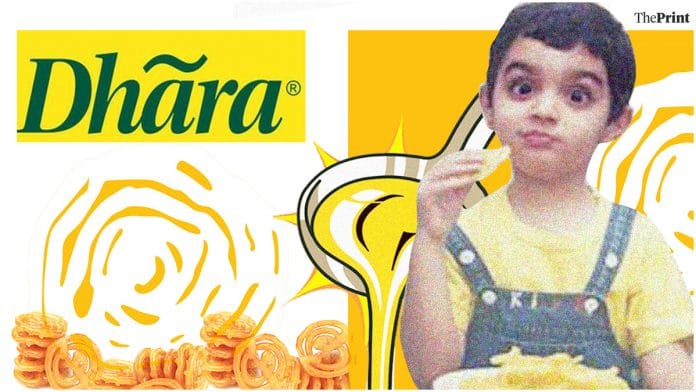A runaway boy, a mischievous smile and a plate of jalebis — Indian millennials don’t need any more clues to bring to mind the iconic Dhara Oil advertisement from the 1990s. They may not be able to identify the taste of food cooked in Dhara, but the image of a four-year-old boy who runs away from home in a fit of pique, but is coaxed back by the thought of his mother’s jalebis, has stuck with audiences like sugar syrup to fingertips.
“I was hungry as ever,” recalls 28-year-old Mumbai-based Parzaan Dastur, who became known as Jalebi Boy, “as my mom brought me to set straight after preschool”. His outfit of a yellow t-shirt and blue dungarees that are now forever associated with Dhara was her impromptu decision, he tells ThePrint, still amazed at how a last-minute request by directors Namita Roy Ghose and Subir Chatterjee went on to air for five years. All it took was the marriage of two clichés: home is where the heart is and the way to a boy’s heart is through his stomach.
The story behind the story
Launched and distributed by the National Dairy Development Board, Dhara was subsidised in the 1980s and it became the largest-selling brand of edible oil. But in the decade to come, the subsidy was withdrawn, and Dhara’s image changed to a brand that people associated with low budgets. Mudra Ahmedabad, which represented the brand, needed to rebrand it, and that came with Jagdish Acharya of Cut The Crap, an ad agency.
He knew Dhara needed to tell a story built on emotions, and he knew he wanted a child in it, but this was the 1990s, when every second TV ad featured a child. After intense brainstorming with his team and his mother (she was the one who suggested jalebis instead of the earlier idea of kachoris (because kids don’t like spicy food, and kachoris wouldn’t be relatable in South India), the now classic advertisement was born.
But there were some glaring plot loopholes — for starters, how a four-year-old was able to run away from home and make it to the train station by himself. Dastur admits, “This is a little unbelievable. In fact, the directors had initially cast a 12- or 13-year-old boy, but when he failed to emote the way they wanted, I was called. But I don’t think audiences were hung up on the boy’s age. The ad was able to steer them to the feeling of coming home, especially for a mother’s cooking”.
The ad was longer than most, at about 60 seconds, but it stuck to a simple plot, some beautiful scene sequences like the image of a bicycle wheel transforming into a jalebi. The ad could have opened with a scene of panic at the house with a missing child, but instead opted for the less dramatic image of a grumpy kid at a train station. It eschewed melodrama and loud theatrics in favour of simple sequences, no more than 10 lines of dialogue, and mostly, just that background tune.
Also read: Ratnam pens — the ‘swadeshi’ pens that were made on Mahatma Gandhi’s demand
Spinoffs and homages
In fact, the tune was established as the Dhara tune in a 2002 sequel. This one featured Dastur, now known as the adorable sardar kid from 1998’s Kuch Kuch Hota Hai (in which, ironically, his one line was also about leaving), as the older brother of a grumpy kid who wants to run away. Dastur as the older brother now persuades him to stay for, you guessed it, jalebis.
“In a way, this older brother filled the shoes of the original’s Ramu Kaka, the old man who finds the boy at the train station and takes him back home on a bicycle [in the original],” says Dastur. In the sequel, Dastur even makes the same hand gesture as Ramu Kaka while saying ‘jalebis’.
But, this wasn’t the only homage. The original ad was so popular, it spurred an UberEats remake even as late as 2018, produced by Kiss Films. It was part of the delivery platform’s campaign to recreate iconic ads by Cadbury, Nirma and Dhara. Except this time, Parzaan Dastur played a 20-something young man who leaves his apartment after an argument with his flatmates, but returns when the building security guard tells him they have just ordered biryani.
“They really wanted me to say ‘biryani’ the way I said ‘jalebi’, you know, with that squeak in my voice!” Dastur tells ThePrint, recalling that he even wore a yellow shirt for the UberEats ad. Now, working behind the camera after starting his own production house, Ten Colour Productions, he says he understands the value of that squeak.
Also read: Boroline — the cure-all that is stuck in time but still brings joy, especially to Bengalis







The ad has an uncanny resemblance to the Pepperidge Farm ad created by Mr David Ogilvy. Of course, it could be entirely coincidental.